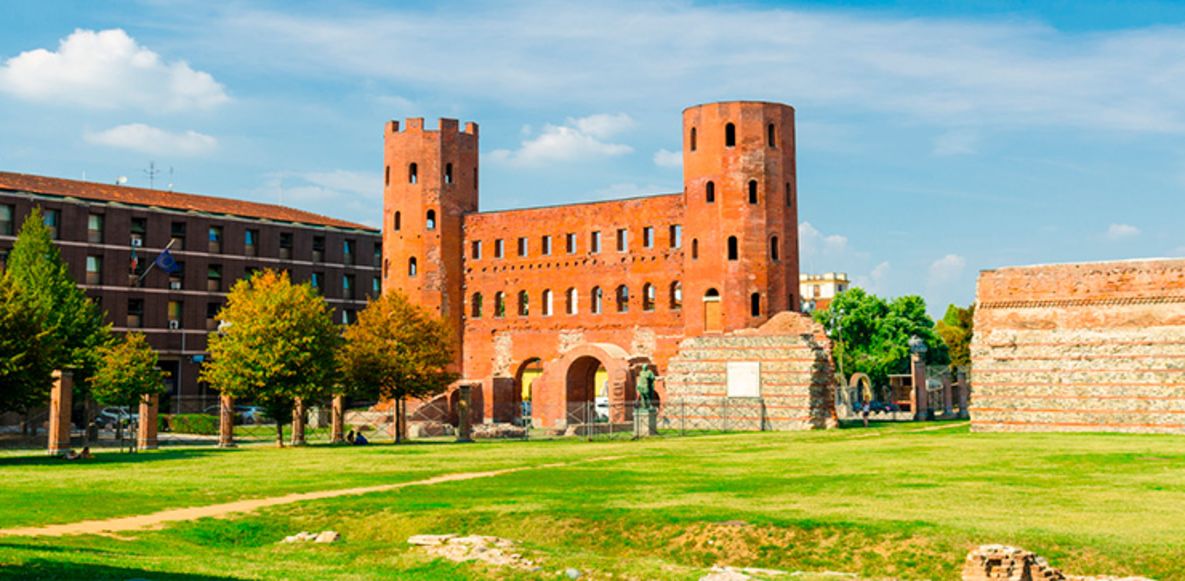Palatine Gate in Turin
Just a few minutes from the Royal Museums complex and from the Royal Palace, stands the Porta Palatina, a point of access in Roman times to Iulia Augusta Taurinorum, the original name of the city. Today it is one of Turin's symbolic monuments and represents one of the best preserved examples of an urban gate of its kind, with two polygonal towers on the sides and a central body with two superimposed orders of windows. For the Romans it was Porta Dorotea, given its proximity to the Dora river, but it changed name in the Lombard era when the city became a duchy under the rule of Agilulf, whose palatium was built a stone's throw from the gate, thus attributing to it the name of Porta Palatina. It is located in the heart of Turin, in the Quadrilatero area, near another urban icon, Piazza Statuto, one of the last of the Savoyard city's Risorgimento history. Over the centuries it has changed name and functions several times until reaching its current state: 2,000 years of life and barely showing it.
The functions of Porta Palatina
The structure of the Gate is defined as a cavidium, typical of the late republican era, although virtually nothing remains of its original form. It was a square courtyard delimited by opposite gates: one towards the city's interior that allowed access to the urbs and the other located in the external walled enclosure that overlooked the countryside, which is why the Turinese refer to the archaeological site as Porte Palatine. Its function was a vestibular one for controlling citizens, foreigners, and merchants, and probably also useful for collecting duties. For some historians, it also represented a possible trap for besiegers who had managed to force the first access gate.
Singular is the religious function attributed to the Gate which, by virtue of a medallion removed during the 19th-century restorations, was meant to ward off evil and keep the city under positive influence. In relief, among other things, the letters IHS indicated the name of Christ in Greek.
Evolution and restorations of Porta Palatina
In 1563 Turin became Savoyard and the city slowly began to expand south, towards the current Piazza San Carlo and Via Roma. The original Roman castrum continued to expand then with Victor Amadeus II who decided to dismantle the last remaining civic gate, namely Porta Palatina, to make way for new buildings in line with the dynasty's idea of grandeur. Thanks to the intervention of military architect Antonio Bertola, Victor Amadeus was dissuaded from the idea of demolishing the structure, although the Savoys subsequently used the complex as a city prison with related accommodation for guards on the upper floors. The same fate befell the polygonal towers used as a military prison and women's penitentiary. In the 18th century, embrasures were also built, i.e., windows that allowed for better ventilation of the prisons that housed criminals, prostitutes, and beggars.
The first restoration works date back to the second half of the 19th century, based on a project by architect Carlo Promis and journalist Davide Bertolotti. In 1872, the swallow-tailed battlements of the towers were removed, as were the walls and part of the constructions leaning against the structure. The archways for carriages and people were also modified. With brickwork, the embrasures and the opening that originally housed the 16th-century stucco medallion were closed.
The other restorations, second and third, were carried out by the Portuguese architect Alfredo D’Andrade and the Turinese engineer Cesare Berta, who together tried to restore a dignified, but above all original, appearance to the Roman structure. The restoration was interrupted during the Second World War and work resumed in the 1930s under the Fascist regime. A square was created in front of the Gate to place two representative statues of Caesar and Augustus to celebrate the city's Latin origins. Both are faithful bronze reproductions of the originals in marble housed at the Museum of Roman Civilization and one at the Vatican Museums. Isola, Durbiano, and Reinero are the latest architects to have carried out interventions on the site, creating a garden in which archeological remains stand out.
Points of interest around Porta Palatina
From Porta Palatina it is possible to reach other historical sites of considerable artistic and cultural relevance. A walk to the Royal Museums is a must, especially due to its proximity to the Gate itself. A little further south, in just a few minutes on foot, you can reach Piazza San Carlo, with the valuable equestrian statue of Emmanuel Philibert of Savoy, or you can turn towards Via Montebello to admire the imposing Mole Antonelliana, a true icon of the city with its 187 meters of height. In the area you can find the Egyptian Museum, with its 40,000 archeological artifacts of the Nilotic civilization for a true journey into history to retrace the daily life, tradition, and religion of the inhabitants of the pyramids.
The Piedmontese city is lively and elegant, enriched by a palpable and significant cultural ferment. A perfect destination for a holiday with family, as a couple, or with friends. It's a city with over 300 kilometers of tree-lined avenues that surprises, pleases, and fascinates. A continuous discovery. Come and visit it at any time of the year and choose our B&B HOTEL Torino President for a perfect stay in the city center: total comfort and best value for money. We await you.



















